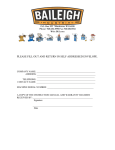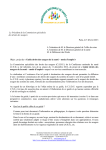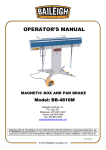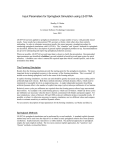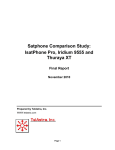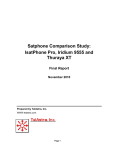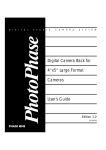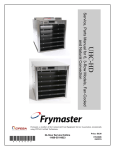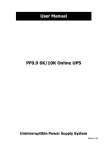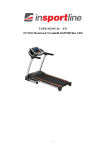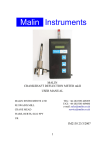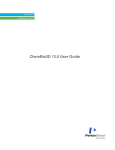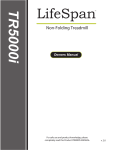Download User Manual - Trick
Transcript
P.O. Box 531 Manitowoc WI 54220 Phone: 920-684-4990 Fax: 920-6843944 Web: Bii1.com PLEASE FILL OUT AND RETURN IN SELF ADDRESSED ENVELOPE. COMPANY NAME: ____________________________________________________ ADDRESS: ____________________________________________________ ___________________________________________________ TELEPHONE: ____________________________________________________ CONTACT NAME: ____________________________________________________ MACHINE SERIAL NUMBER: _________________________________________ A COPY OF THE INSTRUCTION MANUAL AND WARRANTY HAS BEEN RECEIVED BY: _____________________________________________________ Signature _____________________________________________________ Date 1) IMPORTANT INFORMATION AND CONTACTS...........................................................................3 2) INTRODUCTION..................................................................................................................................3 3) SAFETY ................................................................................................................................................4 a) b) Safety Guide....................................................................................................................................4 Safety Precautions ........................................................................................................................4 4) UNPACKING ........................................................................................................................................4 5) INSTALLING ........................................................................................................................................5 6) POWER REQUIREMENTS ................................................................................................................5 7) MAINTAINANCE .................................................................................................................................5 8) OPERATION ........................................................................................................................................6 a) b) c) d) e) f) g) h) i) j) k) l) m) n) Programmer Overview..................................................................................................................6 Machine start-up ............................................................................................................................6 Key Functions (XLE 1) ..................................................................................................................6 Creating a Program .......................................................................................................................7 Dry Running ....................................................................................................................................7 Running a program........................................................................................................................8 Manual Mode ...................................................................................................................................8 Bending and Speed Control........................................................................................................9 Resetting home position ..............................................................................................................9 Reverse Machine Operation ........................................................................................................9 Bending More than 180 degrees ..............................................................................................10 Die Selection and Installation ...................................................................................................10 Material Insertion .........................................................................................................................12 Material Removal/Advancement ..............................................................................................14 9) MATERIAL LAYOUT ........................................................................................................................14 10) BENDING SUGGESTIONS..............................................................................................................14 11) INDEX TABLE ATTACHMENT (OPTIONAL EQUIPMENT) ......................................................17 a) b) c) d) e) 12) a) b) c) d) Introduction ...................................................................................................................................17 Connection to your machine.....................................................................................................17 Height Adjustment and Leveling .............................................................................................17 Material layout ..............................................................................................................................18 Operation .......................................................................................................................................18 WARRANTY .......................................................................................................................................20 Coverage ........................................................................................................................................20 Exclusions .....................................................................................................................................20 Conditions .....................................................................................................................................20 Extended Parts Warranty ...........................................................................................................20 Appendix A. Pipe bending and Tube bending Diagrams...........................................................21 Appendix B. Glossary of Commonly Used Terms .......................................................................22 Appendix C. Pipe OD and Wall Thickness Chart .........................................................................23 2 1) IMPORTANT INFORMATION AND CONTACTS Machine Information Model #250 220VAC, 1 Phase + Neutral, 20 Amp 60Hz 800 lbs/ 363 kg Maximum Sound level < 70 db Distributed By: Baileigh Industrial Inc. PO Box 531 Manitowoc WI 54220 United States Phone 920-684-4990 Fax 920-684-3944 www.bii1.com Manufactured By: Rusch Machine & Design, Inc. PO Box 375 1911 Columbus St. Two Rivers, WI 54241 United States P (920) 793-2936 F (920) 793-9746 www.rmdbender.com 2) INTRODUCTION i) You have made a practical choice in purchasing an RMD, INC. Model #250 Fully Programmable Bending Machine. It has been carefully built of high quality materials and designed to give many years of efficient service. The simplicity of design and minimum effort required to operate the machine contributes towards meeting schedules and producing greater profits. ii) The Model #250 is an electric powered “Rotary Draw” bending machine. To bend material, a bending die and counter die are required. The material is hooked by the bending dies’hook arm and is powerfully rotated in the clockwise direction. As the bending die rotates, the counter die remains stationary, forcing the material to conform to the radius and shape of the bending die. iii) The Model #250 Bending Machine you have purchased is built of solid steel ensuring maximum rigidity. Tongue and groove design with grade 8 bolts throughout provides very high rigidity and stability. iv) In the next chapter of this manual, there are safety-related descriptions for attention. These matters for attention contain the essential information to the operators while operating, and maintaining. Failure to follow these instructions may result in great damage to the machine or the operator. 3 3) SAFETY a) Safety Guide i) Read this manual before operating the machine. Carefully read the safety guide for doing safety work. ii) Keep this manual handy for answers to any questions you may have. Store it near the machine to be usable in the future. iii) Operators and maintenance workers shall not depend on only the safety equipment. They shall familiarize and understand the machine before operating and maintaining the machine. b) Safety Precautions i) Before being engaged in operating this machine, please read and understand the entire instruction manual, and follow all the warning signs labeled on the machine. Do not disfigure or remove. ii) During operation, please do not expose any of your body parts near to the moving parts of the machine. iii) Never touch workpiece, tooling or spindle unless the spindle stops completely. iv) Before operation, make sure all the guards are in place. v) Before starting the machine, make sure that all workpiece and die tooling are properly installed to avoid accidents. vi) Operators should wear safety glasses, and remove rings, watches, jewelry and loose fitting clothing for their own protection while operating the machine. vii) Never touch switches or controls with wet hands. viii) Cut off the power immediately if there is electricity power breakdown. ix) Before proceeding with the daily operation, the machine should be warmed up for approximately one minute. x) There must be no obstacles to obstruct the operator while in the working area xi) If machine is going to be left unattended, the operator should turn power off until the beginning of the next task. xii) Please do not put any tools or measuring devices on the moving parts of the machine, or on the control panel. xiii) Identify and make sure of the function of the switches or buttons on the control panel, and then proceed to operate them. 4) UNPACKING i) After receiving machine, visually inspect for damage. Any damage should be reported immediately to RMD, Inc. before power is applied to machine. ii) The machine weight is approximately 800 pounds. Extreme care should be taken when unloading from skid. A forklift is the best way to remove machine from the skid. 4 5) INSTALLING i) Once unloaded and wheels and casters attached, the machine can be wheeled to the operator’s desired location. ii) Be sure to rest machine on a flat surface iii) The electrical connection must be inspected by a certified electrician, and the incoming voltage must be verified to be correct before the machine is turned on. Have a certified electrician verify that the power source is correct for the machine’s specifications, and that the plug is correct and properly grounded to an earth ground. The warranty is void if incorrect power is supplied to the machine. iv) The machine is supplied with a lockable disconnect switch, the machine must be locked out for any maintenance work. 6) POWER REQUIREMENTS AC Voltage AC Voltage AC Voltage Frequency 20 Amps 220V (208-240) 480v 575v (Single Phase) (3 phase) (3 phase) 60 Hz The power source cable should be protected by fuse or breaker, and dedicated to this machine only. 7) MAINTAINANCE i) The gearbox oil should be checked monthly, and changed every three years with 80 W90 gear lube. ii) Check periodically for leaks. If a leak is detected, consult RMD, Inc. iii) On very hot days, gear oil may drip from the breather; this is normal expansion of the oil. iv) Be sure to keep the slide ways and lead screws lubricated with light hydraulic oil or equivalent. v) The only grease zerk on the machine feeds the main spindle bearing. Grease this zerk every six months with only one pump from a standard grease gun. vi) Check for any worn or damaged parts and replace immediately. 5 8) OPERATION a) Programmer Overview i) The Model 250 utilizes a fully programmable operator interface. The unique operator interface allows you to write and save 170 programs with 10 bends per program. Operation is extremely simple to learn. Simple foot pedal controls allow you to easily produce fast and accurate bends. The following instructions will walk you through the basic functions. ii) Be sure to follow the dry running instructions to familiarize yourself with all the functions of the control before any actual bending of material is performed. b) Machine start-up i) Turn on the main disconnect switch. ii) It takes about 1 minute for the programmer to boot up. iii) Once powered up the RMD main screen will be displayed. (XLE 1) iv) The bender comes with the home position preset from the factory. The control will remember its position unless the encoder or any of the spindle mechanics are disassembled. If the home position is lost it can be reset. (see section i) c) Key Functions (XLE 1) i) The programmer keys are labeled for easy navigation. (1) Key #1 Main/Exit (a) Returns to main screen and goes back one screen at a time. (2) Key #2 System/ OEM (a) Directs you to the contact page as well as OEM password protected screens. (3) Key # 3 Cancel (a) Cancels an Entry. (4) Key #4 Save (a) Use this Key to save changes. This will also be an O, Z, and #1 for data entry. (5) Key #5 Bend / ? (a) Use this key to scroll through bends “down” will also be A, B, C, and #2 for data entry. (6) Key #6 Edit (a) Use this key to enter the edit program screen. (XLE 3) This will also be the P, R, S, and #7 for data entry. (7) Key #7 Run (a) Use this key to run a desired program, choose program from the program selection screen. (XLE 2) This button will also be the W, X, Y, and #9 for data entry. 6 (8) Key #8 ? / Bend (a) Use this Key to scroll through the bends “Up”. This will also be used for G, H, I and #4 for data entry. (9) Key #9 Enter (a) Use this key to activate a field to change/ add data as well as storing the data after a change is made. (10) Key #10 Manual bend (a) Use this key to enter the manual bend screen. (XLE 4) (11) Key #11 Edit/ Run Programs (a) Use this key to enter the program selection screen (XLE 2) Here is where you can select: (i) View programs (ii) Edit programs (iii) Run programs d) Creating a Program (1) From the RMD main screen (XLE 1) Press Edit/ Run Programs (2) The Programmer selection screen will be displayed (XLE 2) (3) Choose a Bend # using the side arrow keys or Press 1 through 5. The Program Selection will be displayed in the upper left corner. (4) To change or edit the program, press the Edit key (#6). (5) The edit screen is now displayed (XLE 3) here you can enter: (a) Program Name (b) Bend angle (c) Spring back (d) Speed Press the more arrow. (XLE 6) (e) Counter die position (f) Material Rotation Press the more arrow. (XLE 7) (g) Part count memory (6) To enter Data: (a) Use the arrow keys to put the dashed selection box around the field that you are changing (XLE3, 5). Press enter, this allows the data to be changed. Using the numerical keys, enter in the desired data. Press enter again to store the data. e) Dry Running i) Once you are familiar with the machine and programming unit, it is important to dry run a few programs without any tooling installed. ii) Follow the next steps (In sections F and G) to produce a generic bend and dry run without material. iii) Repeat this process as many times as needed to fully understand the functions and controls. 7 DO NOT ATTEMT TO OPERATE IF YOU ARE NOT CONFIDENT, OR DON’T UNDERSTAND THE CONTROLS. iv) Feel free to consult the factory with any questions. f) Running a program i) From the RMD main screen(XLE 1) press Edit/ Run Programs (Key #11) ii) The Program Selection Screen (XLE 2) will be displayed. iii) Select the program you want to run using the side arrow keys or by pressing the 1-5 keys iv) The selected program will be displayed in the upper left box v) Once the desired program is selected, press the “run” key ( Key #7) vi) The run program screen (XLE 8) will now be displayed. vii) This screen will give you all of the information needed for this particular bend. (1) Actual machine position (2) Program name (3) Programmed bend angle (4) Spring Back (5) Material rotation (6) Speed (7) Counterdie Position ( This correlates to the leadscrew counter position (Fig 6)) (8) Bend Sequence number out of a possible 10 bends for the program (9) Number of completed bends viii) If the information displayed is correct, activate the “forward foot pedal control. The degree counter will display the current degrees and will stop at the programmed degree of the bend (Degrees plus the additional springback value) ix) At this point, activate and hold the “Rev’foot pedal control until the screen displays “Bend is done”. The machine position will be 0.0 to -0.4, this amount of variance is OK, and it does not affect the accuracy of the machine. x) The programmer will automatically switch to the next bend in the sequence. The parameters for that bend will be displayed on the screen. xi) Repeat steps viii and ix, until all bend for the program are completed. The sequencing will restart to the first bend in the sequence after the last bend is completed. xii) If it is required to skip past a bend in a sequence or to start on a different bend sequence, simply press the Bend ? (Key #5) or Bend ? (Key #8) on the bend keys until the desired bend in the sequence is displayed. g) Manual Mode (1) The manual bend mode allows the user to preset one bend angle for quick bending. 8 (2) From the RMD main screen (XLE 1) Press “Manual Bend “key #10. (3) The Manual Bend screen will be displayed. (XLE 4) (4) These are the fields that can be changed. (a) Bend angle (b) Spring back (c) Bend Speed (5) To enter or change data, use the arrow keys to put the dashed selection box around the field that you are changing. Press enter, this allows the data to be changed. Using the numerical keys, enter in the desired data. Press enter again to store the data. (6) Also displayed on this screen are: (a) Actual machine position (b) Analog degree indicator (c) Amperage Draw (Machine Load) (7) To run the program, activate the foot pedals as in the previous steps. h) Bending and Speed Control i) After the desired degree is programmed, bending can take place. ii) Follow previous steps iii) Keep hands away from the bending zone. iv) Press and hold the forward foot pedal until bend is complete. v) Always start out using slower speeds with heavier material and increase as needed. i) Resetting home position i) If the home position is lost it can be reset ii) From the RMD main screen (XLE 1) press “System/OEM” (Key #2). The RMD contact page will be displayed (XLE 13) iii) Press the arrow right key and the homing screen will be displayed (XLE 14) iv) Press the “0” key and the home setting screen will be displayed (XLE 14) v) Follow the directions on the screen to position the spindle back to 0 degrees vi) Save the new position by holding the Save Key Don’t Change the home position unless you are sure the position was lost, damage to the machine and tooling can occur if the home position is set incorrectly j) Reverse Machine Operation i) It is possible to run this machine in the counter clockwise direction ii) Contact Rusch Machine & Design, Inc. for applications and Password (XLE 16-21) 9 k) Bending More than 180 degrees i) This machine is capable of bending more than 180 degrees; contact Rusch Machine & Design about your application. l) Die Selection and Installation Damaged or worn tooling should be replaced before attempting to bend material. This will ensure that bends are correct and provide a longer life to machine components. Before any bending can take place, the proper die set must be chosen to match the material being bent. (EX) 1-1/2”diameter tubing requires a die set marked 1-1/2” tube. Note: Pipe and Tube are not the same, see chart in appendix c for nominal pipe sizes. All RMD dies are color coded to avoid confusion between tube and pipe. Material Pipe Tube Metric Square or Rectangle Color Green Blue Red Gray Caution: When installing large dies use either a mechanical lift or a fork lift to prevent serious personal injury. Figure 1 Spindle drive pins and hold down bolts 10 i) To install the die, slip the die over the centering pin until the three unequally spaced drive pins engage the receiving holes formed in the die (Note: The die will only fit one way). When the drive pins line up the die will drop all the way down to the spindle. If bolt holes are provided in the die ensure that the die is bolted to the spindle with the ½-13 bolts and lock washers provided with the die. Figure 2 Hold down bolts on the die FAILURE TO PROPERLY BOLT DOWN DIE WILL RESULT IN DAMAGE TO MACHINE. To install the counter die, Remove the hitch pin & insert the counter die in the opening in the counter die mount until the ¾” holes line up. Now insert the hitch pin through all the holes, reinstall clip on the hitch pin with the engraved side of the counter die facing up. Figure 3 Installing counter die 11 IMPORTANT: Be sure the long end of the counter die points away from the hook arm, or to the right of machine. m) Material Insertion i) At the start page, choose “RUN PROGRAM” and choose program to run following screen instructions. ii) Once the die set is properly installed and the desired program is loaded and performs as needed, the correct size material can now be inserted. Figure 4Lubricating counterdie Figure 5 inserting material to start bending With the die head at home or “0” position, insert material past the hook arm aligning the “0” mark on the die with where the bend will start on the material. IMPORTANT: Liberally apply lubricant along the material and counter die with a WD-40 style lubricant or equivalent. Do not lubricate the die. Lubricating the die will encourage slipping of material in the die. iii) Tighten the counter die assembly applying moderate pressure on the material. iv) With the counter die tight, document the number displayed on the leadscrew counter, you will want to return to the same exact number every time to ensure exact counter die positioning and repeatable bends. 12 Figure 6 Leadscrew counter v) Be sure there are no obstructions along the draw side of the material. vi) Be sure to leave enough material past the plastic slide to produce the desired bend. Figure 7 Not enough material to complete the bend Figure 8 Correct amount of material left Figure 9 Maximum amount material can be pulled through the counterdie 13 n) Material Removal/Advancement i) After the die stops at the desired angle, the material needs to be removed or advanced if using an Index Table (See section 11). ii) Activate the reverse foot pedal momentarily to relieve pressure. CAUTION: DO NOT REVERSE OR HOME ALL THE WAY WITH THE COUNTER DIE UP TIGHT iii) Open the counter die assembly using the three legged hand wheel allowing the removal or advancement of the material from the die and hook arm. iv) Once the material is removed, activate the Reverse foot pedal and hold until the die reaches its home or “O” position. If you are using an index table, open the counter die and then reverse machine, holding material in place. Be careful when reversing with material still in die, not to catch it on the hook arm of the die. v) Repeat previous steps for next bend in line. 9) MATERIAL LAYOUT In order to create accurate parts, you will have to layout the material in flat form. First you will need to determine how much material is used per degree of bend. Use the multiplier table on Table #1 to determine the arc lengths for the die in use. Or use the following formula: Alternate arc length formula (clr x 2) x pi x degree of bend 360 a) Once the arc lengths are determined you can begin layout of the material using Diagram #1 as a reference. b) Diagram #1 shows a simple part bent on the same plane in the same direction c) Diagram #2 shows bending based off of a centerline in two directions d) For symmetrical bends, centerline bending is easiest. e) For non-symmetrical bends, continuous one direction bending is best. 10) BENDING SUGGESTIONS a) ALUMINUM: If bending aluminum, lubrication is very important, if the results are less than desirable with WD-40 other lubricants can be used such as: i) Johnson Paste Wax (seems to work the best) ii) High Pressure grease iii) Highly rich dish soap 14 iv) The bronze counter die must be polished and have no aluminum deposits or it will continue to pick up metal. v) If using RMD’s standard counterdie is not producing desired results, roller counter dies are also available. vi) Some aluminum will crack as it is being bent, 6061-T6 is very hard and may need to be annealed or ordered in the “T-0” condition. b) HEAVY WALL DOM TUBING: If heavy wall materials are bent to a tight radius, they can tend to slip in the hook arm causing a poor bend result, below are some suggestions i) Use a vise clamp on the outside of the hook arm to “lock” the material in place. ii) Use a piece of two sided coarse emery cloth in between the hook arm and the material, this works very well. iii) In only this application, high pressure grease applied to the DIE GROOVE also helps. c) Bending with square dies i.) Die parts 1) Main bending die 2) Die cap 3) Quick release handles 4) Hookarm 5) Hookarm clamp 6) Plastic slide 7) Slide mount ii.) Square Tooling Setup 1) Install the bending die (1) on to the spindle. Be careful not to pinch your fingers as you lower the die on to the spindle. The die will only fit on the spindle one way. Bolt the die to the spindle using the holes in the die. 2) Install the plastic counter die assembly (6, 7) with the long end pointing away from the hook arm 3) Snug up the cap clamps (3). Do not over tighten! Or they will be overly difficult to loosen after the bend is complete. Note: tighten clamps without material in the die. The clamps are lift and turn, so you can position them anywhere. This allows the handles to clear the counterdie mount during bending. 4) Insert the material in to the hook arm (4) and pull in to the die. It may be a tight fit. Continue to pull until the material is fully seated in the die’s groove. 15 5) Lube the counter die and the material that will slide along the counter die. Bring the plastic counter die assembly up to the material, leaving about 1/8” to 1/4" gap. (Note: on some thinner material it helps to keep the counter die approx 1” away from the material) 6) Important: Do not lube the bending die surfaces. This will increase the possibility for slippage. 7) Caution: make sure all the die cap clamp handles (3) are inside the die diameter. They could catch the counter die mounting assembly and break off. 8) If the material slips during the bending operation, install the hook arm clamp (5). Do not use it unless you have to. 9) Activate the bender and bend to the desired angle. 10) To remove the material, open the counter die and return bender to the “home position”. Using a soft mallet, gently tap the cap clamps open and the material will spring out of the die (1). Remove the material and re-snug the cap clamps. 11) Install the next piece of material to be bent and repeat steps 1-9. d) LARGE DIAMETER SQUARE: When bending large diameter thinner wall square tubing, the counter die position seems to work better between ½ and 1”farther away from the die. This seems do reduce side wall distortion and inner wrinkling. Although this suggestion is to help on large diameter, the same steps can be used for any square, if trying to achieve better results. If the square material slips in the hook arm, use the supplied clamp and bolts to hold in place. 16 ITEM NO. 1 2 3 4 5 6 7 8 PART NUMBER D-1500S-R500 DC-R500-625 .625 HANDLE H-1500S-R500 HC-1500S PS-1500S CDM-0016 .625 X 3.0 STUD DESCRIPTION 1.500 SQUARE DIE 5.0 RADIUS DIE CAP .625 HANDLE 1.5 X 5.0 CLR HOOK ARM 1.500 HOOK CLAMP 1.5 SQUARE SLIDE 2.5 THICK SQ C'DIE MOUNT .625 X 3.0 STUD QTY. 1 1 5 1 1 1 1 5 3 8 2 1 6 7 5 PROPRIETARY AND CONFIDENTIAL THE INFORMATION CONTAINED IN THIS DRAWING IS THE SOLE PROPERTY OF RUSCH MACHINE & DESIGN, INC.. ANY REPRODUCTION IN PART OR AS A WHOLE WITHOUT THE WRITTEN PERMISSION OF RUSCH MACHINE & DESIGN, INC. IS PROHIBITED. 4 DIMENSIONS ARE IN INCHES TOLERANCES: FRACTIONAL ANGULAR: MACH BEND TWO PLACE DECIMAL THREE PLACE DECIMAL MATERIAL Material <not specified> NEXT ASSY USED ON APPLICATION NAME DRAWN CHRIS RUSCH DATE RUSCH MACHINE & DESIGN CHECKED ENG APPR. MFG APPR. 1.5 SQUARE DIE SET ASS'Y Q.A. COMMENTS: FINISH SIZE DO NOT SCALE DRAWING A DWG. NO. SCALE:1:8 DH-1500S-R500 WEIGHT: 58.54 SHEET 1 OF 1 REV. 0 11) INDEX TABLE ATTACHMENT (OPTIONAL EQUIPMENT) a) Introduction i) The IDX-10 Indexing table was designed to allow you too accurately and repeatedly position distances between bends, by using the adjustable stops. Also the IDX-10 can be used to hold the material being bent perfectly level while bending, or altering the angles between bends. b) Connection to your machine i) Remove the shaft mounting bracket [#2] (angle iron) leaving the slide shaft [#16] in place. ii) Slide the front of the main track tube [#1] onto the slide shaft [#16]. iii) Reattach the shaft mounting bracket [#2] and tighten bolts. iv) With the front of the main track tube attached, lift up the rear and support it with a sturdy saw horse or equal. v) Attach the rear leg adjuster [#13] using the supplied 3/8 X 1” bolts. vi) Align the keyways with the slide bolt and slip the caster mount [#12] onto the leg adjuster [#13]. c) Height Adjustment and Leveling i) Level your machine on a flat hard surface. (The index table must be allowed to pivot and rotate with the casters.) ii) With the machine level, choose the desired die set. iii) The thickness of the die determines the height of the index table. Using the chart shown below find the correct number of turns required for your die. iv) Rotate the height adjustment screw [#21] clockwise until it stops. This is the lowest the table will go. (EXAMPLE 1-1/2 die) v) Rotate the adjustment screw [#21] counter clockwise the exact number of turns that were chosen from the chart. vi) Using a 2 ft level placed on the main track tube, rotate the large nut [#35] until the main track tube is level. vii) Position the front of the main track tube so the center line of the track tube matches the center (radius) line of the die. viii) The Chuck/Gearbox assembly is designed to pivot on its mount, tension is adjusted with spring washers beneath the (2) ½-13 mounting bolts. 17 d) Material layout i) Before you can use the IDX table, your first piece of material needs to be laid out. Using Diagram1 and Table1 you can determine all of the bend start points, these points should be transferred to the material using a fine point sharpie marker. This diagram is a generic two bend scenario, for more complex parts the steps are generally the same. Use section 10 for further reference. e) Operation i) After the connection to your machine is complete, and the height and center line positions are verified, the IDX-10 can be used. ii) Your first part should now be clearly marked. These marks will be used to position the tubing perfectly with the “0” mark on the die, and to set your IDX stops. Only your first part needs to be marked, after that the IDX stops will be used. iii) Insert a piece of material through the hook arm of the die being used and insert through the chuck. (note: If multiple parts are being produced, the material should be marked so the chuck position can be repeated) position the material so the start of bend mark lines up with the “0”mark on the die, now set your first stop on the index table and produce the first bend. NOTE: The complete table will swing, be sure not to interfere with the motion. iv) After the bend is complete, the die must return to home. Once the die is home, the material can be advanced and rotated (if required) to the next “0” mark. The next stop can now be set. Repeat as required, your IDX table comes standard with (4) stops. CAUTION! Make sure the hook arm of the die does not catch the tubing when returning. v) The previous steps are just examples how to set stops and produce various bends; it is up to the user to define exactly how his/her IDX will be set up. RMD will be glad to offer any suggestions for your application. 18 HEIGHT ADJUSTMENT CCW TO RAISE TURNS CCW DIE THICKNESS 0.0 1.50 2.5 2.00 5.0 2.50 7.5 3.00 10.0 3.50 19 12) WARRANTY a) Coverage (1) Rusch Machine & Design, Inc. warrants to the original purchaser for use that the products sold by RMD, Inc. will be free from defects in workmanship and material for a period of one year from the date of purchase provided such goods are installed, operated, maintained and used in accordance with RMD, Inc.’s written instructions. b) Exclusions (1) Ordinary wear and tear, and damage from abuse, neglect or alterations are not covered by this warranty. THIS WARRANTY IS NULL AND VOID IF INSTRUCTIONS AND OPERATING PROCEDURES ARE NOT FOLLOWED. (2) Die sets are excluded from warranty. (3) Machine maintenance, adjustments, setups or downtime costs are excluded from warranty. Rusch Machine & Design, Inc. will in no event be liable for incidental or consequential damages. c) Conditions (1) All warranty work must be approved by RMD, Inc. (2) All defective items must be returned to RMD, Inc. for inspection. (3) Customer pays freight, travel and all other associated costs other than parts and labor d) Extended Parts Warranty All electrical components and gearboxes carry a one-year replacement warranty from manufacturer. Replacement labor not included. Customer pays freight costs. Any questions pertaining to this limited warranty should be addressed to: Rusch Machine & Design, Inc. P.O. Box 375 Two Rivers, WI 54241 20 Appendix A. Pipe bending and Tube bending Diagrams Legend L = Arc length (outside) R = Rise (inside) D = Tube outside diameter t = Tube wall thickness a= First bend arc angle b= Second bend arc angle A= First tangent B= Straight between bends C= Second tangent D= Tube outside diameter H= Height of offset L = Length of offset R1= First radius R2= Second radius t= Tube Wall Thickness 21 Appendix B. Glossary of Commonly Used Terms Arc Length – The length of material along the centerline of the tubing Centerline Radius (CLR) - Distance in inches from the center of curvature to the centerline axis of the tube bending or pipe bending bends. Abbreviated as CLR. See Tube Bending and Pipe Bending Diagram Degree - Angle in degrees to which the tube/pipe bends are formed (i.e. 45 degrees, 90 degrees, 180 degrees, etc.) Easy Way (EW) - Bending of a rectangular tube with its short side in the plane of the tube or pipe bend Hard Way (HW) - Bending of a rectangular tube with its long side in the plane of the tube or pipe bend I.D. - Inside diameter of the tube or pipe bends Minimum Tangent - The minimum straight on the end of pipe bends required by the bending machine to form the bend Neutral Axis - That portion of the pipe or tube that is neither in compression or tension. O.D. - Outside diameter in inches of the tube or pipe Out of Plane - The deviation of the horizontal plane of a single pipe bend between its tangent points, based on the theoretical center-line of the pipe bend Ovality - The distortion or flattening of pipe or tube from its normal, round shape caused by the pipe bending process Springback – Amount of degrees material will return after bending pressure is released Tangent - The straight portion of material on either side of arc of bending bends. See Tube Bending and Pipe Bending Diagrams. Tangent Point - The point at which the bend starts or ends. See Tube Bending and Pipe Bending Diagrams. Wall - The thickness in inches of tubular pipe bending material. Wrinkles - Waving or corrugation of pipe bending bends in the inner radius. 22 Appendix C. Pipe OD and Wall Thickness Chart Pipe O.D. Pipe Schedules and Wall Thickness Sizes 80 5s 5 10s 10 40s 40 80s & Std & E.H. 1/8 0.405 0.040 0.050 0.050 0.068 0.070 0.095 0.100 1/4 0.540 0.050 0.070 0.070 0.088 0.090 0.119 0.120 3/8 0.675 0.050 0.070 0.070 0.091 0.090 0.126 0.130 1/2 0.840 0.070 0.070 0.080 0.080 0.109 0.110 0.147 0.150 3/4 1.050 0.070 0.070 0.080 0.080 0.113 0.110 0.154 0.150 1 1.315 0.070 0.070 0.110 0.110 0.133 0.130 0.179 0.180 1 1/4 1.660 0.070 0.070 0.110 0.110 0.140 0.140 0.191 0.190 1 1/2 1.900 0.070 0.070 0.110 0.110 0.145 0.150 0.200 0.200 2 2.375 0.070 0.070 0.110 0.110 0.154 0.150 0.218 0.220 2 1/2 2.875 0.080 0.080 0.120 0.120 0.203 0.203 0.276 0.280 160 Dbl. E.H. 0.190 0.220 0.250 0.250 0.280 0.340 0.380 0.294 0.308 0.358 0.382 0.400 0.436 0.552 All sizes are in inches 23 TABLE 1 ARC LENGTH TABLE EXAMPLE: ARC LENGTH = CONSTANT X BEND RADIUS EXAMPLE: 90DEG BEND WITH 6" CLR EXAMPLE: 1.575 (FROM TABLE) X 6" (CLR) =9.45" (ARC LENGTH) FOR BENDS MORE THAN 90 DEG, CONSTANTS CAN BE ADDED TOGETHER DEGREES 1 2 3 4 5 6 7 8 9 10 11 12 13 14 15 16 17 18 19 20 21 22 23 24 25 26 27 28 29 30 CONSTANT 0.0175 0.0349 0.0524 0.0698 0.0873 0.1047 0.1222 0.1396 0.1571 0.1745 0.1920 0.2094 0.2269 0.2443 0.2618 0.2792 0.2967 0.3141 0.3316 0.3490 0.3665 0.3839 0.4014 0.4188 0.4363 0.4537 0.4712 0.4886 0.5061 0.5235 DEGREES 31 32 33 34 35 36 37 38 39 40 41 42 43 44 45 46 47 48 49 50 51 52 53 54 55 56 57 58 59 60 CONSTANT 0.5410 0.5584 0.5759 0.5933 0.6108 0.6282 0.6457 0.6631 0.6806 0.6980 0.7155 0.7329 0.7504 0.7678 0.7853 0.8027 0.8202 0.8376 0.8551 0.8725 0.8900 0.9074 0.9249 0.9423 0.9598 0.9772 0.9947 1.0121 1.0296 1.0470 DEGREES 61 62 63 64 65 66 67 68 69 70 71 72 73 74 75 76 77 78 79 80 81 82 83 84 85 86 87 88 89 90 CONSTANT 1.0645 1.0819 1.0994 1.1168 1.1343 1.1517 1.1692 1.1866 1.2041 1.2215 1.2390 1.2564 1.2739 1.2913 1.3088 1.3262 1.3437 1.3611 1.3786 1.3960 1.4135 1.4309 1.4484 1.4658 1.4833 1.5007 1.5182 1.5356 1.5531 1.5705 Appendix D. Troubleshooting Problem Machine does not power up Oil leaking from Breather Home Position is not correct Material slips in the hookarm Spindle drive pins are damaged Poor Bend Results Solution Check circuit breakers Wrong Power, Check for Proper voltage Oil will expand when the gearbox gets hot, causing oil to purge from the breather, this is normal Go through the homing sequence in section Too much lube on material and is transferring to the bend die clean the bend die with degreaser. The counter die should be lubed only The material may need to be clamped Wrong material for the die set If the bend dies are not bolted down properly the drive pins will get damaged. Replace drive pins. Check proper tooling for material IE Pipe Vs Tube. Green for pipe, Blue for tube, Red for metric and Gray for square or rectangle tubing. See pipe sizing chart Wall thickness is too thin 24 Key #11 Key #1 Key #2 Key #10 Key #3 Key #9 Key #4 Key #6 Key #5 Key #7 Key #8 XLE 1 RMD startup screen 25 XLE 2 Program Selection Screen XLE 3 Edit Program screen XLE 4 Manual Bend XLE 5 Edit Screen 26 XLE 6 Edit Screen XLE 7 Part Count Memory 27 Actual Machine Position Program Name Counterdie Position Bend Angle Speed Springback Material Rotation Bend Sequence # in Program # of Bends Completed XLE 8 Run Program Screen 28 XLE 9 Run Program Screen XLE 11 Run Program Screen XLE 10 Run Program Screen XLE 12 Run Program Screen 29 XLE 13 Contact Information XLE 14 Machine Homing Screen XLE 15 Homing Instruction Screen 30 XLE 1610 Password Screen XLE 18 Bend Direction Selection XLE 1711 Password Protected Menu XLE 19 Bend Direction Selection 31 XLE 20 Bend Direction Selection XLE 21 Reverse Direction Screen 32







































